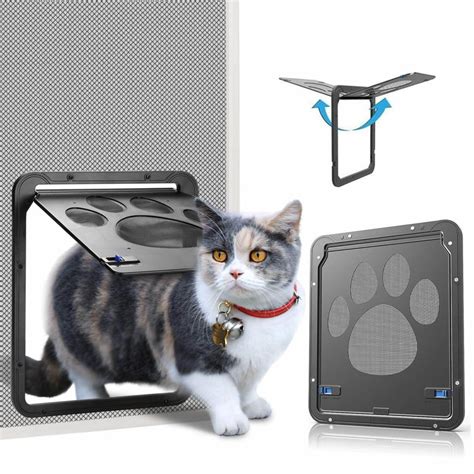Introduction

Do you adore your feline friend but also cherish the convenience of a pet door? If so, look no further than this comprehensive guide to ensure a seamless cat door installation and setup experience. Whether you’re a seasoned DIY enthusiast or a novice seeking expert guidance, we’ve got you covered!
Table 1: Types and Features of Cat Doors
| Type | Features | Pros | Cons |
|---|---|---|---|
| Flap Cat Door | Flexible flaps; easy for cats to use | Affordable; weather-resistant | Can be noisy |
| Sliding Cat Door | Horizontal sliding panel; weather-tight | Quiet; pet-proof | More expensive |
| Electronic Cat Door | RFID technology; only allows access for authorized pets | Secure; prevents strangers from entering | Requires power; can be expensive |
| Magnetic Cat Door | Magnetic strips; closes automatically | Energy-efficient; quiet | Can be finicky; not suitable for large cats |
Step-by-Step Installation Guide
Materials you’ll need:
- Cat door
- Jigsaw or hole saw
- Measuring tape
- Level
- Pencil
- Screwdriver
- Caulk
1. Choose the Right Door for Your Cat
Consider your cat’s size, activity level, and the location of the door when selecting a model. Measure your cat’s height at the shoulder and width across the chest to determine the appropriate size.
2. Plan the Door Placement
Choose a location that allows easy access for your cat without obstructing furniture or creating tripping hazards. Consider the flow of traffic and the safety of your pet.
3. Cut the Hole
Use a jigsaw or hole saw to cut a hole in the door. The hole should be 6-8 inches wider than your cat’s chest and 1 inch taller than their shoulder.
4. Align and Secure the Door
Place the cat door in the hole and align it with the edges. Secure it using the provided screws or bolts.
5. Seal the Gaps
Apply caulk around the edges of the cat door to seal any gaps and prevent drafts.
Setup Tips
- Train your cat: Introduce your cat to the cat door gradually. Show them how to use it and reward them for passing through.
- Adjust the flap tension: Most flap cat doors allow you to adjust the tension to suit your cat’s strength and weight.
- Secure the door: Install a security lock or bolt on the cat door to prevent unauthorized access.
- Maintain the door: Regularly clean the door and lubricate the hinges or sliding tracks to ensure smooth operation.
Benefits of Installing a Cat Door
- Convenience: Allows your cat to come and go as they please, reducing your need to monitor them constantly.
- Independence: Gives your cat a sense of freedom and control over their surroundings.
- Improved mental health: Access to the outdoors promotes healthy physical and mental stimulation for cats.
- Energy conservation: Can help regulate indoor temperature by allowing cats to enter and exit without opening windows or doors.
- Safety: Provides a safe and controlled way for your cat to explore the outdoors without risking escape or injury from predators.
Pain Points and Motivations
- Cost: Cat doors can range in price from affordable to expensive. Consider your budget and the features you need before purchasing.
- Installation difficulty: Installing a cat door can be challenging, especially if you’re not comfortable with DIY projects. Consider hiring a professional if necessary.
- Security concerns: Some cat doors can be easy for intruders to access. Choose a model with security features to prevent unauthorized entry.
- Compatibility issues: Not all cat doors are compatible with all types of doors. Ensure the door you choose fits your door thickness and material.
Why It Matters
Installing a cat door not only provides convenience and freedom for your beloved pet but also enhances their health and well-being. By carefully considering the type of door, placement, and setup tips outlined in this guide, you can create a safe and enjoyable environment for your furry friend.
Table 2: Cost Comparison of Cat Door Types
| Type | Average Cost |
|---|---|
| Flap Cat Door | $20-$100 |
| Sliding Cat Door | $150-$300 |
| Electronic Cat Door | $250-$500 |
| Magnetic Cat Door | $20-$80 |
Table 3: Estimated Installation Time
| Type | DIY Experience | Estimated Time |
|---|---|---|
| Flap Cat Door | Beginner | 1-2 hours |
| Sliding Cat Door | Intermediate | 2-3 hours |
| Electronic Cat Door | Advanced | 3-4 hours |
| Magnetic Cat Door | Beginner | 30-60 minutes |
Table 4: Security Features of Cat Doors
| Type | Security Features |
|---|---|
| Flap Cat Door | Limited; may require additional locking mechanisms |
| Sliding Cat Door | Some models offer built-in locks or bolts |
| Electronic Cat Door | RFID technology; only allows access for authorized pets |
| Magnetic Cat Door | Magnetic strips; can be easily disengaged |
Conclusion
Embarking on a cat door installation and setup project can be a rewarding experience, offering numerous benefits for both you and your furry companion. By following the detailed guidance and tips provided in this article, you can ensure a smooth and successful installation that will bring endless joy and convenience to your home for years to come.
Remember, as the saying goes, “A cat with access is a happy cat.” So, let your feline friend enjoy the freedom and independence they deserve with a well-installed cat door, tailored to their unique needs and your own peace of mind.





















